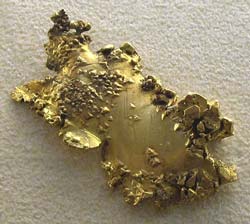|
|
|
 Gold is one of the most precious and valuable metals in the world. Found in bodies of water and the earth’s crust, gold jewelry has been popular for eons. There are many different ways to present the metal in jewelry, and the way that the metal’s color and consistency can be manipulated to match almost any desire. Gold is one of the most precious and valuable metals in the world. Found in bodies of water and the earth’s crust, gold jewelry has been popular for eons. There are many different ways to present the metal in jewelry, and the way that the metal’s color and consistency can be manipulated to match almost any desire.
Because gold can come in so many forms, there is a grading system designed to alert the goldsmith and the buyer how valuable the item is, and what it is made of. Because pure gold is extremely soft, other metals are mixed with the gold to make the piece more durable, less expensive, and to alter it’s color.
All jewelry is required by law to be stamped so consumers will know the quality of gold used. Jewelry made in North America is typically marked with the karat grade (10K, 14K, etc.), and jewelry made in Italy is typically marked with the "fineness" such as (417, 583, etc.). So if your jewelry does not have a karat grade stamped on it, check for a 3-digit fineness number.
Chances are the ring on your finger is marked 18K, 14K, or 10K, with the K standing for karat, the system used to describe the percentage of pure gold an item contains.
|
24K | 100% pure gold.
No other metal has been mixed.
18K | 75% gold.
Contains 18 parts gold and 6 parts of one or more additional metals.
14K | 58.3% gold.
Contains 14 parts gold and 10 parts of one or more additional metals.
12K | 50% gold.
Contains 12 parts gold and 12 parts of one or more additional metals.
10K | 41.7% gold.
Contains 10 parts gold and 14 parts of one or additional metals.
Minimum karat that can be called "gold" in the United States.
|
|
You'll find examples of pure gold jewelry, but pure gold is soft and isn't practical for daily wear. Other metals are mixed with it to make it more durable (and to lower its cost).
Adding other metals to the mix also allows metallurgists to change the color of gold. Palladium or nickel can be added to create white gold. Adding copper produces a rose or pink tint, while silver gives gold a greenish cast.
When metals are added to the gold the result is an alloy, a blended mixture of the metals that you can think of as a very expensive cake batter. Solid gold is a term that can be used to describe an item that's at least 10K (in the US) gold all the way through. Even though it's a gold alloy--18K, 14K, or anything down to 10K--it can be called solid gold.
Gold jewelry never goes out of style, and for good reason, because gold is as wearer-friendly as it is beautiful. Pure gold doesn't react with other elements to create tarnish, the residue that accumulates on some metals before transferring to your skin as a stain. Sometimes people have allergy or staining problems with metals that are combined with gold, but the gold itself is rarely a problem.
Gold can be worked into nearly any shape, from tiny strands that do not break easily to very thin sheets. One ounce of gold can even be hammered into an ultra thin sheet that's ten feet square. Gold can be manipulated nearly any way the artisan desires.
Gold is one of the most precious metals in the world. It is present in the rivers, seas, and the earth's crust and trace amounts are present in plants and animals. It is, however, difficult and expensive to extract. In modern mining operations approximately 3 tons of ore are needed to extract one ounce of gold. The many desirable qualities found in gold, along with its scarcity, have made it the most popular metal for use in jewelry today.
|
|
Pure gold comes in yellow, but it can be produced in shades of rose, white, green, and even two-tone. None of these additional colors are natural, and instead produced by mixing pure 24K yellow gold with various other metals. The percentage of the other metals (copper, silver, zinc, and nickel) produces the different shades of gold.
|
|
Rose gold is also known as pink gold or red gold, and is a mixture of pure yellow gold with a high percentage of copper. It has a very subtle and delicate color that may intensify somewhat with age due to a slight, but commonly regarded as attractive, tarnishing of the copper alloy. Rose gold is created by increasing the copper-colored alloys mixed with the gold, and decreasing the silver-colored alloys. 14K rose gold contains as much pure gold as 14K yellow gold but, because of the increased copper, is slightly pinker in color.
|
|
White gold is created by increasing the silver-colored alloys (zinc, silver, nickel) normally mixed with gold and decreasing the copper-colored alloys. 14K white gold contains as much gold as 14K yellow gold but is nearly white in color.
|
|
Green gold is created by mixing an alloy of pure yellow gold and pure silver. For rings, harder metals such as nickel or zinc are sometimes added to make the gold more durable. The green color, like rose gold, is very subtle and is most noticeable when it is used in a piece of jewelry next to areas of yellow, white, and pink gold.
|
|
